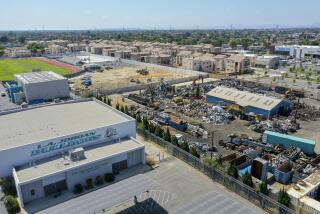Corporate Pressure Blamed in Explosion
- Share via
A federal prosecutor said Thursday that corporate pressure on workers to dispose of chemical wastes led to the deadly 1994 explosion that killed two scientists at Rocketdyne’s Santa Susana Field Laboratory in Ventura County.
To get rid of the waste faster, field lab workers illegally burned leftover rocket fuel under the guise of research, Assistant U.S. Atty. William Carter said in his opening statement at the trial of two former Rocketdyne employees charged with environmental crimes. “They were burning 10, 15, 20 pounds of heavy-duty bad stuff” at a time, he said.
Joseph E. Flanagan, 60, of Stanwood, Wash., and Edgar R. Wilson, 65, of Chatsworth, each face two felony counts of illegally disposing of hazardous wastes. Flanagan, who was director of Rocketdyne’s Chemical Technology Group, also is accused of illegally storing the materials. If convicted, they face up to five years in prison and a $250,000 fine on each of the counts.
The defendants are not charged in the deaths of the workers. U.S. District Judge Robert J. Timlin has ruled that prosecutors cannot mention the deaths to the jury but can say the explosion caused injuries.
The blast on July 26, 1994, triggered by burning chemicals, killed Otto K. Heiney, 53, of Canoga Park, and Larry A. Pugh, 51, of Thousand Oaks. No one has been prosecuted in the deaths. Rocketdyne’s then-parent company, Rockwell International Corp., paid $6.5 million in fines for mishandling hazardous chemicals in the explosion.
In August, James F. Weber, the group’s hazardous waste coordinator, pleaded guilty to illegally storing explosive materials, a misdemeanor, and faces up to a year in prison. He is expected to testify against his former colleagues.
Flanagan’s attorney John D. Vandevelde, and Wilson’s attorney, Leonard Sharenow, are set to give their opening statements today in Timlin’s Riverside courtroom.
In his two-hour statement, Carter said testimony will show that Flanagan and Wilson knew certain “tests” at were actually cover-ups for the illegal burns. The defendants “are rocket scientists,” he said. “They knew exactly what was going on.”
Carter said Rocketdyne officials ordered Flanagan to clean up the field lab. If Flanagan did not get rid of the wastes, “he was out of a job,” the prosecutor said.
Until 1990, Rocketdyne disposed of the materials in a burn pit. The company stopped doing so after being fined $600,000 for burning more chemicals than its permit allowed. Without the burn pit, Flanagan’s group had to find an alternative, Carter said.
A March 1994 fire in scrap materials later drew attention to the long buildup of “oddball” wastes at the lab, which is now owned by Chicago-based Boeing Co. “As a result of that, Mr. Flanagan and his group decided to do a little housekeeping,” Carter said.
Carter said among the witnesses he will call is Judy Heiney, who will say that her husband told her about the pressure to dispose of hazardous materials. Heiney told authorities that her husband talked about how to “get around . . . stupid environmental rules” for waste disposal, Carter said.
“How were they going to do that? Burn it,” Carter said.
Two co-workers, Bertram Moy and Gary Schnittgrund, will testify about similar conversations they had with Heiney before the explosion, Carter said. Schnittgrund contacted the FBI shortly after the blast, initiating the criminal investigation.
Although the trial is expected to take months, Carter told jurors the violations of the Federal Resource Conservation and Recovery Act will be easy to prove.
“This is a very, very simple case,” the prosecutor said.
The evidence, he said, will show that five men, including Wilson, disposed of the wastes by putting sawdust on the bottom of a large pan, pouring the chemicals over it and igniting them. On July 21, 1994, a spark from such a burn started a brush fire, Carter said.
Five days later, the men gathered again to burn materials, this time covering them with boxes to prevent sparks from flying, he said. “That last burn exploded,” Carter said. “A violent explosion. Boom.”
More to Read
Sign up for Essential California
The most important California stories and recommendations in your inbox every morning.
You may occasionally receive promotional content from the Los Angeles Times.













![Vista, California-Apri 2, 2025-Hours after undergoing dental surgery a 9-year-old girl was found unresponsive in her home, officials are investigating what caused her death. On March 18, Silvanna Moreno was placed under anesthesia for a dental surgery at Dreamtime Dentistry, a dental facility that "strive[s] to be the premier office for sedation dentistry in Vitsa, CA. (Google Maps)](https://ca-times.brightspotcdn.com/dims4/default/07a58b2/2147483647/strip/true/crop/2016x1344+29+0/resize/840x560!/quality/75/?url=https%3A%2F%2Fcalifornia-times-brightspot.s3.amazonaws.com%2F78%2Ffd%2F9bbf9b62489fa209f9c67df2e472%2Fla-me-dreamtime-dentist-01.jpg)